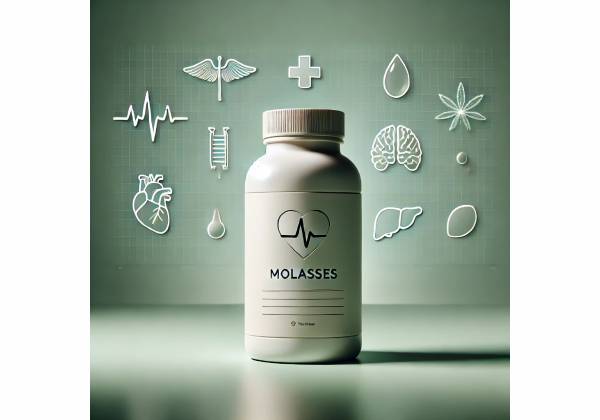
Molasses is a thick, dark syrup made when sugarcane or sugar beets are refined into sugar. What sets it apart from other sweeteners is its trace mineral content and robust flavor. A single tablespoon delivers small amounts of iron, calcium, magnesium, and potassium while providing the caramel-bitter notes bakers love. Blackstrap molasses—the third, most concentrated boil—contains the highest mineral levels and the deepest taste. Despite these advantages, molasses is still an added sugar and should be used thoughtfully, especially for people monitoring blood glucose or total sugar intake. As a pantry staple, it shines in gingerbread, baked beans, barbecue sauces, and marinades; a teaspoon in oatmeal or coffee can also add complexity. In wellness circles, you will see claims about iron, antioxidants, and even digestion. Some of these ideas have a basis in food chemistry and early-stage research, yet none make molasses a cure-all. This guide explains what molasses can (and cannot) do, how to use it, sensible amounts, and who should avoid it.
Quick Overview
- Provides small amounts of iron (about 1–1.5 mg/tbsp) and minerals like calcium, magnesium, and potassium.
- Still an added sugar (~10–15 g/tbsp); keep within daily limits for sugars.
- Typical culinary use: 1–2 teaspoons to 1 tablespoon (7–21 g) per day, depending on total sugar goals.
- Choose unsulfured molasses if you are sensitive to sulfites; people with chronic kidney disease should limit high-potassium foods.
Table of Contents
- What is molasses?
- Does molasses offer real benefits?
- Best ways to use it in cooking
- How much molasses per day?
- Risks, side effects, and who should avoid
- Evidence at a glance
What is molasses?
Molasses is the concentrated syrup left after sugar crystals are removed from sugarcane or sugar beet juice. Each round of boiling and centrifuging pulls out more sucrose, leaving a thicker, darker, and more mineral-dense syrup. This progression creates three broad culinary types:
- Light (first boil): Mild, pourable, and the sweetest. Good for cookies and light sauces.
- Dark (second boil): Fuller, slightly bitter, and more aromatic. Useful for baked beans, gingerbread, and marinades.
- Blackstrap (third boil): The darkest and least sweet, with a pronounced bittersweet note and the highest ash (mineral) content.
Two additional labels matter:
- Unsulfured vs. sulfured: Unsulfured molasses is made from ripe sugarcane or beets without sulfur dioxide; it has a cleaner flavor and is better tolerated for those sensitive to sulfites.
- Cane vs. beet molasses: Both are sweeteners, but they differ subtly in mineral profiles and flavor. Cane molasses is more common in home baking and classic American recipes; beet molasses can be more saline-bitter.
From a nutrition standpoint, molasses supplies modest amounts of micronutrients that refined white sugar lacks. The typical tablespoon (about 20–21 g) provides roughly 58–60 kcal and 10–15 g of sugars, plus trace minerals. Amounts vary by brand and batch, but realistic ballpark values are:
- Iron: ~1–1.5 mg per tablespoon in many products; some blackstrap brands are higher.
- Calcium: ~40–150 mg per tablespoon (blackstrap tends toward the upper end).
- Magnesium: ~40–50 mg per tablespoon.
- Potassium: ~300–600 mg per tablespoon.
These amounts are meaningful in cooking terms but still small relative to daily needs. For example, menstruating adults often need 18 mg of iron per day; even a mineral-rich tablespoon of molasses covers only a fraction of that. In other words, molasses can help nudge intake upward but is not a stand-alone solution for deficiencies.
Molasses also contains organic acids and plant phenolics (especially in cane blackstrap), which contribute to flavor complexity and antioxidant capacity. That makes it unique among table sweeteners, though again, the presence of these compounds does not negate the fact that molasses is still sugar.
Culinarily, think of molasses as a flavoring sweetener—like vanilla, coffee, or cocoa, it brings aroma, color, and body to recipes alongside sweetness. Its acidity can also activate baking soda for lift and spread.
Does molasses offer real benefits?
Short answer: yes—but within the boundaries of a sweetener. The strongest practical advantages are nutritional “trade-ups” compared with refined white sugar and the way molasses can replace part of other added sugars in flavorful dishes. Three areas stand out:
1) Micronutrient bump compared with white sugar.
Refined sugar contributes calories but no vitamins or minerals. Molasses, particularly blackstrap, can supply small amounts of iron, calcium, magnesium, and potassium. That does not transform it into a multivitamin, but it can help diversify mineral sources in a day’s meals. For people who struggle with iron intake, an extra 1–1.5 mg per tablespoon is a helpful nudge, especially when paired with vitamin C-rich foods (citrus, berries, peppers) that improve non-heme iron absorption.
2) Phytochemicals and flavor density.
Cane molasses contains phenolic compounds and Maillard reaction products that contribute to its bold color and bittersweet notes. Early-stage research on molasses polyphenol extracts (not table molasses itself) has shown antioxidant and anti-inflammatory effects in experimental models. In plain language: the same compounds that make molasses taste robust are also of scientific interest. This is promising for ingredient development, though it does not make a spoonful of molasses a therapeutic dose.
3) Real-world sugar reduction through substitution.
Because molasses is highly aromatic, it can reduce the need for sheer sweetness. A teaspoon of blackstrap molasses plus spices (ginger, cinnamon, clove) often replaces a larger quantity of white sugar while delivering a “perceived” sweetness and complexity. For home cooks trying to cut added sugars, this is a practical trick: use less total sweetener by leaning on molasses’ flavor. In sauces, braises, and baked beans, that swap is both culinary and metabolic progress.
What molasses does not do.
It is not a substitute for iron therapy, a blood sugar balancer, or a digestive cure. Although molasses has lower sucrose content than white sugar by weight (due to water, minerals, and other compounds), it still raises blood glucose and counts toward daily added sugar limits. For constipation, the traditional “milk and molasses” enema is a medical procedure, not a dietary strategy, and should not be replicated at home. As a drink sweetener, molasses adds sugars just like honey or syrup; flavorful or not, the grams still count.
Bottom line: the benefits are incremental and culinary, not clinical. If you already use sweeteners, choosing molasses in certain recipes can deliver a richer taste and slightly better nutrient profile, particularly for iron, calcium, magnesium, and potassium—so long as it fits inside your added sugar budget.
Best ways to use it in cooking
Molasses brings four things to a dish: sweetness, bitterness, acidity, and color. When you understand those levers, you can use smaller amounts and still get a big payoff.
Baking and sweets
- Gingerbread and spice cookies: For classic snap and chew, use dark or blackstrap. Pair with ginger, cinnamon, cloves, and a pinch of black pepper.
- Quick breads and muffins: Swap part of the sugar for molasses (start with 25–33 percent of the total sweetener) and add ½–1 teaspoon baking soda per cup of molasses used to neutralize acidity and help rise.
- Granola and energy bites: A small amount (1–2 teaspoons) adds stickiness, color, and a toffee finish without pushing the mix overly sweet.
Savory dishes
- Baked beans and braises: Combine 1–2 tablespoons with tomato paste, mustard, and vinegar to build a deep, smoky backbone.
- Barbecue sauce: Use 1 tablespoon per cup of sauce alongside apple cider vinegar, paprika, and garlic for gloss and umami.
- Glazes for roasted vegetables or salmon: Whisk 1 teaspoon molasses with soy sauce, citrus, and grated garlic; brush on during the last 5–10 minutes.
Beverages and breakfast
- Oatmeal or porridge: Stir in ½–1 teaspoon with a pinch of salt and cinnamon.
- Coffee or chicory coffee: A ½ teaspoon can replace flavored syrups; the bitterness complements dark roasts.
- Smoothies: If you already include fruit, cap molasses at ½ teaspoon to avoid oversweetening.
Technique tips
- Start small: Because flavor is intense, ½–1 teaspoon can be enough in most single-serving applications.
- Balance acidity: Molasses is acidic. In baking, pair with baking soda; in sauces, add vinegar or citrus to brighten and keep sweetness in check.
- Mind moisture: Molasses is hygroscopic (attracts water). It yields softer, chewier textures. In cookies, reduce other liquids slightly if swapping large amounts.
- Choose type by dish: Light for delicate treats, dark for all-purpose depth, blackstrap for pronounced bittersweet notes and color.
- Storage: Keep tightly capped in a cool cupboard. If it crystallizes or thickens, warm the jar gently in hot water and stir.
Recipe-level sugar downsizing example
If a sauce calls for 3 tablespoons brown sugar, try 1 tablespoon molasses + 1 tablespoon brown sugar, then taste. Spices and acidity (vinegar, mustard) will often let you drop the third tablespoon entirely without missing sweetness.
How much molasses per day?
There is no official “dosage” for molasses—it is a food sweetener, not a supplement. Sensible amounts follow the broader rules for added sugars and personal health goals.
A practical daily range
- Adults: 1–2 teaspoons to 1 tablespoon (7–21 g) per day as part of your total added sugars, not in addition to them.
- Children and teens: Occasional small amounts (for example, ½–2 teaspoons in a recipe). Prioritize overall added sugar limits.
- Under age 2: Aim to avoid added sugars entirely in line with healthy eating guidance.
Why portion matters
A tablespoon of molasses supplies about 58–60 kcal and ~10–15 g sugars depending on brand and style. If your daily goal is to keep added sugars below 10 percent of calories, someone eating 2,000 kcal/day should cap added sugars around 50 g. That means one tablespoon of molasses may account for 20–30 percent of the day’s allowance. Many people prefer to keep it at 1–2 teaspoons and “spend” the rest elsewhere (yogurt, sauces, occasional dessert).
Using molasses for iron: a reality check
Blackstrap molasses is commonly discussed for iron. It can provide roughly 1–1.5 mg per tablespoon in many products, sometimes more depending on the batch. This is useful but modest—especially for menstruating adults or those with diagnosed iron deficiency whose daily needs are much higher (often 18 mg or a prescribed therapeutic regimen). If you choose to nudge iron intake with molasses:
- Pair with a vitamin C source (citrus, berries, bell pepper) to aid absorption.
- Use food first, not molasses alone, to meet needs (beans, lentils, meats, fortified grains, leafy greens).
- Do not self-treat any anemia with sweeteners; seek diagnosis and a tailored plan.
Timing and pairing
- With meals, not on an empty stomach, to moderate glycemic impact.
- Pair with protein, fiber, and fat (e.g., oatmeal with nuts, yogurt with spices) to smooth the glucose curve.
- In baking, account for acidity with baking soda as noted earlier.
Special cases
- Athletes sometimes add ½–1 teaspoon to post-training oatmeal or yogurt for flavor and trace minerals; the main recovery nutrients are still carbs, protein, and fluids.
- Vegetarian eaters may use 1 teaspoon daily in sauces or dressings to add a small non-heme iron bump while relying on beans, tofu, seeds, and fortified foods for the bulk of iron.
Bottom line: Think of molasses as a flavor amplifier that can fit into a limited sugar budget. For many people, 1–2 teaspoons per day is the sweet spot; 1 tablespoon is reasonable on days you plan around it.
Risks, side effects, and who should avoid
Even traditional foods have caveats. With molasses, the issues are straightforward: added sugar, potassium load, sulfite sensitivity, digestive tolerance, and dental health.
1) Added sugar and blood glucose
Molasses raises blood sugar and counts toward daily added sugars. People with diabetes, prediabetes, or insulin resistance should use it sparingly and pair it with fiber, protein, and fat. The goal is not to replace one sweetener with a lot of another; it is to use less overall.
2) Potassium considerations
Blackstrap molasses can contain ~300–600 mg potassium per tablespoon. For most healthy adults, this is fine—potassium is generally beneficial. However, people with chronic kidney disease (CKD) or those advised to follow a low-potassium diet need to monitor intake. If you take potassium-sparing diuretics, ACE inhibitors, or other medications affecting potassium, ask your clinician how molasses fits your plan.
3) Sulfite sensitivity
Some molasses is “sulfured” with sulfur dioxide during processing. Individuals sensitive to sulfites (often those with asthma or prior reactions) may experience wheezing or hives. Choose unsulfured products and always check labels if you have a known sensitivity.
4) Digestive tolerance
Large amounts of molasses can cause loose stools, gas, or cramping, especially if you are not accustomed to concentrated syrups. Start with ½–1 teaspoon and observe your response. Historical medical uses like milk-and-molasses enemas are clinical procedures and not a home remedy.
5) Dental health
Like all sugars, molasses feeds oral bacteria that cause cavities. Rinse or brush after sticky sweets, and avoid frequent sipping of molasses-sweetened drinks.
6) Allergies and intolerances
True molasses allergy is rare. If you have beet or cane sensitivities, proceed cautiously. For gluten-free diets, pure molasses is gluten-free; cross-contact is possible in flavored syrups or processed foods—read labels.
Who should avoid or limit
- People with CKD or anyone on a medically supervised low-potassium plan.
- Individuals with sulfite sensitivity (choose unsulfured).
- Those on tight glucose targets (reduce serving size; avoid in sweet beverages).
- Children under 2 years—aim to avoid added sugars entirely.
- Anyone with iron overload conditions (e.g., hemochromatosis) does not need extra iron from sweeteners.
Interactions
There are no well-documented, specific drug–molasses interactions beyond the potassium-medication point above. If you take iron supplements, you can still cook with molasses, but do not count it toward your therapeutic regimen.
Safe use checklist
- Pick unsulfured by default.
- Keep servings to 1–2 teaspoons most days; plan for 1 tablespoon occasionally.
- Use with meals and pair with fiber/protein.
- Maintain regular dental care and rinse after sticky sweets.
- If you have CKD or sulfite sensitivity, seek personalized guidance.
Evidence at a glance
What we know with confidence
- Molasses is an added sugar that contributes calories and affects blood glucose, so it belongs within daily added sugar limits.
- Compared with white sugar, molasses contains small amounts of minerals (notably iron, calcium, magnesium, potassium). These can supplement an overall healthy diet but do not replace nutrient-dense foods or supplements when clinically needed.
- Unsulfured molasses is preferred for those with sulfite sensitivity.
What is promising but preliminary
- Cane molasses polyphenols show antioxidant and anti-inflammatory activity in laboratory and animal models. This supports the idea that molasses contains bioactive compounds of interest, but these findings do not convert directly into clinical outcomes from routine culinary use.
- Specialty ingredients derived from molasses (e.g., filtered molasses concentrates or standardized phenolic extracts) are being studied for functional properties in foods and potential health effects. These are not the same as everyday table molasses.
What is not supported
- The idea that molasses alone can treat anemia or improve bone health is not supported by clinical trials. At best, it contributes small amounts of non-heme iron and minerals within a broader diet.
- Claims that molasses has a “free pass” on blood sugar are inaccurate. Portions still matter.
Practical takeaway
Use molasses as a culinary upgrade: it improves flavor density, may help you use less total sugar in recipes, and offers modest mineral contributions. Respect serving sizes, choose unsulfured if needed, and fit it within your overall nutrition plan.
References
- Sugarcane Molasses Polyphenol Extract Attenuates Alcohol-Induced Chronic Liver Damage via Antioxidant, Anti-Inflammatory, and CYP2E1/Keap1/NF-κB Pathway Modulation 2025 (RCT/Preclinical)
- Dietary Guidelines for Americans, 2020-2025 2020 (Guideline)
- Iron Fact Sheet for Consumers 2022 (Guidance)
- Healthy Eating for Adults with Chronic Kidney Disease 2025 (Guidance)
- Guideline: Sugars Intake for Adults and Children 2015 (Guideline)
Disclaimer
This article provides general nutrition information about molasses and is not a substitute for personalized medical advice, diagnosis, or treatment. Always consult a qualified health professional about your specific health needs, especially if you have diabetes, chronic kidney disease, a sulfite sensitivity, iron deficiency, or take medications that affect potassium.
If you found this guide useful, consider sharing it on Facebook, X, or your favorite platform, and follow us for more evidence-based nutrition articles. Your support helps us keep producing quality content. Thank you.










